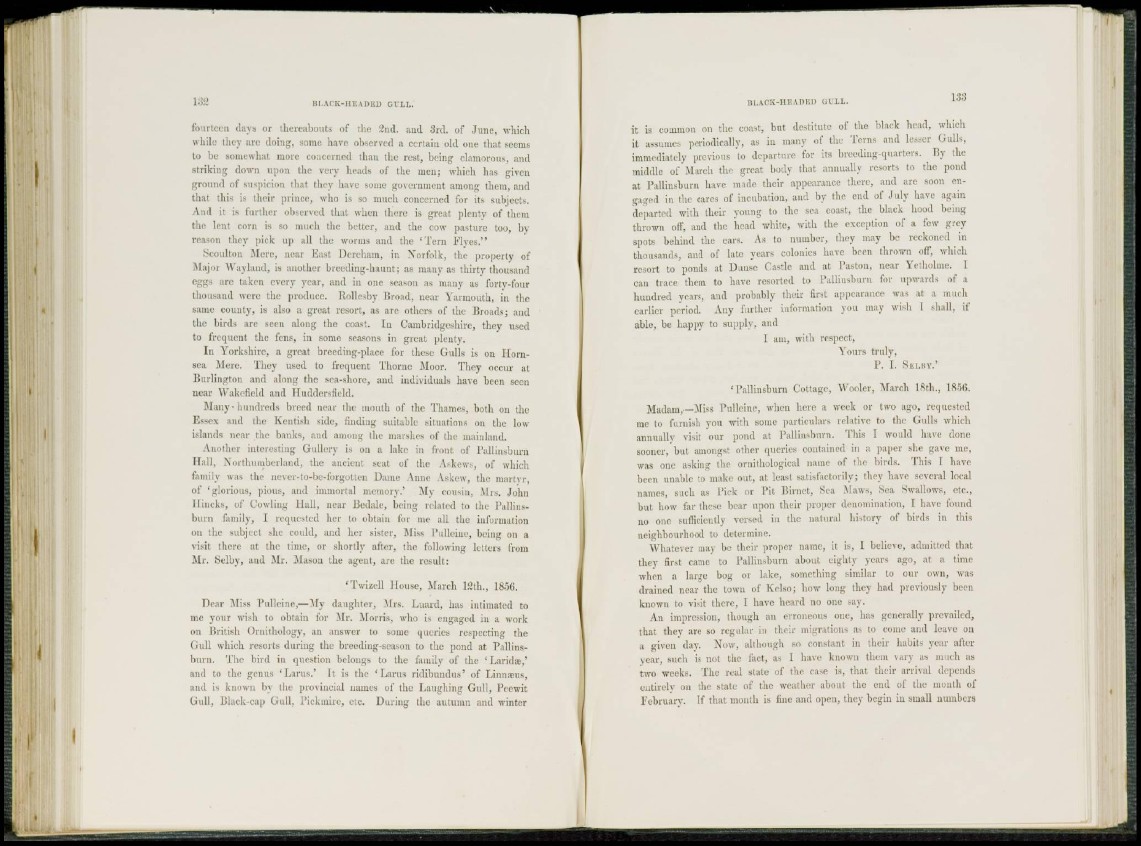
fourteen days or thereabouts of the 2nd. and 3rd. of June, which
while they arc doing, some have observed a certain old one that seems
to be somewhat more concerned than the rest, being clamorous, and
striking down upon the very heads of the men; which has given
ground of suspicion that they have some government among them, and
that this is their prince, who is so much concerned for its subjects.
And it is further observed that when there is great plenty of them
the lent corn is so much the better, and the cow pasture too, by
reason they pick up all the worms and the ' Tern Flyes."
Scoulton Mere, near East Dereham, in Norfolk, the property of
.Major Wayland, Is another breeding-haunt; as many as thirty thousand
eggs are taken every year, and in one season as many as forty-four
thousand were the produce, llollesby Broad, near Yarmouth, in the
same county, is also a great resort, as are others of the Broads; and
the birds are seen along the coast. In Cambridgeshire, they used
to frequent the fens, in some seasons in great plenty.
Iu Yorkshire, a great breeding-place for these Gulls is on Hornsea
Mere. They used to frequent Thorne Moor. They occur at
Burlington and along the sea-shore, and individuals have been seen
near Wakefield and I (uddersfield.
Many-hundreds breed near the month of the Thames, both on the
Essex and the Kentish side, finding suitable situations on the low
islands near the banks, and among (he marshes of the mainland.
Another interesting Gallery is on a lake in front, of Pallinsburn
Hall, Northumberland, the ancient seat of the Askcws, of which
family was the never-to-be-forgotten Dame Anne Askew, the martyr,
of 'glorious, pious, and immortal memory.' My cousin, Mrs. John
llincks, of Cowling Hall, near Bedalc, being related to the Pallinsburn
family, I requested her to obtain for me all the information
on the subject she could, and her sister, Miss Pulleine, being on a
visit there at the time, or shortly after, the following letters from
Mr. Selby, and Mr. Mason the agent, are the result:
'Twizell House, March 12th., 1856.
Dear Miss Pulleine,—My daughter, Mrs. Luard, has intimated to
me your wish to obtain for M i ' . Morris, who is engaged in a work
on British Ornithology, an answer to some queries respecting the
Gull which resorts during the breeding-season to the pond at Pallinsburn.
The bird in question belongs to the family of the 'Laridffl,'
and to the genus 'Earns.' It is the 'Larus ridibuiidus' of Linnams,
and is known bv the provincial names of the Laughing Gull, Peewit
Gull, Black-cap Gull, Pickmue, etc. During the autumn and winter
it is common on the coast, but destitute of the black head, which
it assumes periodically, as in many of the Terns and lesser Gulls,
immediately previous to departure for its breeding-quarters. By the
middle of March the great body that annually resorts to the pond
at Pallinsburn have made their appearance there, and are soon engaged
in the cares of incubation, and by the end of July have again
departed with their young to the sea coast, the black hood being
thrown off, and the head white, with the exception of a few grey
spots behind the ears. As to number, they may be reckoned in
thousands, and of late years colonics have been thrown off, -which
resort to ponds at Dunse Castle and at Paston, near Yetholme. I
can trace them to have resorted to Pallinsburn for upwards of a
hundred years, and probably their first appearance was at a much
earlier period. Any further information you may wish I shall, if
able, be happy to supply, and
I am, with respect,
Yours truljy,
P . I. SKLBY.'
'Pallinsburn Cottage, AVoolcr, March 18th., 185(5.
Madam,— Miss Pulleine, when here a week or two ago, requested
rae to furnish you with some particulars relative to the Gulls which
annually visit our pond at Pallinsburn. Tins I would have done
sooner, but amongst other queries contained in a paper she gave me,
was one asking the ornithological name of the birds. This 1 have
been unable to make out, at least satisfactorily; they have several local
names, such as Pick or Pit Birnet, Sea Maws, Sea Swallows, etc.,
but how far these bear upon their proper denomination, I have found
no one sufficiently versed in the natural history of birds in this
neighbourhood to determine.
Whatever may be (heir proper name, it is, I believe, admitted that
they first came to Pallinsburn about eighty years ago, at a time
when a large bog or lake, something similar to our own, was
drained near the town of Kelso; how long they had previously been
known to visit there, I have heard no one say.
An impression, though an erroneous one, has generally prevailed,
that they arc so regular in their migrations as to come and leave on
a given day. Now, although so constant in their habits year after
year, such is not the fact, as I have known them vary as much as
two weeks. The real state of the ca>c. is, that their arrival depends
entirely on the stale of the weather about the end of the month of
February. If that month is fine and open, they begin in small numbers